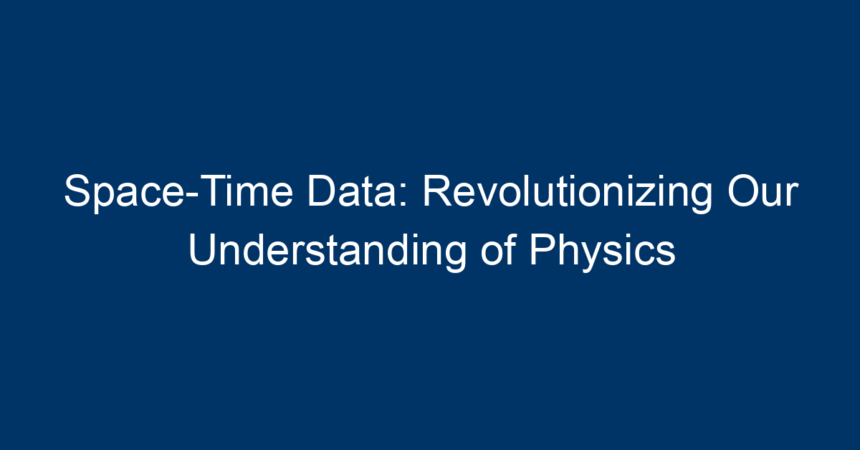In the ever-evolving field of physics, the concept of space-time has stood the test of time, reshaping our understanding of the universe. Enter space-time data—an advanced paradigm that leverages cutting-edge technologies to acquire, analyze, and interpret the intricate relationship between space and time. This article delves deep into how space-time data is revolutionizing physics, transforming everything from fundamental theories to practical applications in various fields.
The Essence of Space-Time in Physics
Before we can appreciate the revolutionary nature of space-time data, it’s crucial to understand what space-time actually is. Introduced by Albert Einstein through his theory of relativity, space-time merges the three dimensions of space with the dimension of time into a four-dimensional continuum. This concept allows us to describe how objects move and interact in the universe in a more unified and coherent manner.
Understanding Relativity and Beyond
Einstein’s theories of special and general relativity introduced revolutionary ideas about speed, gravity, and the fabric of the universe itself. These theories rely heavily on the concept of space-time, altering our interpretations of gravitational fields and accelerating objects. Space-time data takes these theories further by providing empirical evidence and data-driven insights that refine our understanding further.
What is Space-Time Data?
At its core, space-time data encompasses information about physical events that occur in both time and spatial dimensions. This data can include coordinates of celestial bodies, events like supernovae, or even micro-level interactions such as particle collisions. With advances in technology, scientists can now harness space-time data through various means:
1. Satellite Observations
Satellite technology has drastically improved the quality and variety of space-time data available. These systems allow for the precise tracking of astronomical phenomena, contributing to fields such as astrophysics and cosmology. For instance, telescopes and sensors collect light and other signals from distant galaxies, resulting in unparalleled insights into the universe’s structure.
2. Particle Accelerators
High-energy particle accelerators like the Large Hadron Collider not only propel particles to close to the speed of light but also generate an immense amount of space-time data. These experiments provide invaluable insights into the fundamental particles and forces that govern the universe.
3. Gravitational Wave Detection
The recent discovery of gravitational waves represents a groundbreaking leap in space-time data acquisition. Instruments like LIGO detect ripples in space-time caused by massive cosmic events like black hole mergers. This not only confirms predictions made by general relativity but also opens a new window into understanding the universe.
How Space-Time Data is Changing Physics
The application of space-time data has led to significant shifts in how we understand a variety of concepts in physics. Here’s a breakdown of key areas affected:
Advances in Cosmology
Space-time data has propelled the field of cosmology into new realms. The mapping of the Cosmic Microwave Background (CMB) radiation, a remnant from the Big Bang, has been enhanced by large datasets. This has allowed researchers to create more accurate models of the universe’s expansion and composition, shedding light on dark matter and dark energy.
Understanding Gravity
Research into gravitational waves provides a fresh perspective on gravity, challenging previous notions. The data collected from these waves offers crucial insights into the nature of gravity, suggesting it is not merely a force but a curvature of space-time itself. This has implications for future theoretical developments and may even lead to a unified theory of gravity and quantum physics.
Quantum Mechanics and Space-Time
The intersection of quantum mechanics and space-time is a fertile ground for exploration. Space-time data is crucial in testing and establishing quantum theories, guiding physicists toward potential breakthroughs. By accurately mapping quantum events within a space-time framework, researchers hope to clarify the mysteries surrounding quantum entanglement and superposition.
Practical Applications of Space-Time Data
The implications of space-time data extend far beyond theoretical physics. Here are some practical applications that highlight its importance:
GPS and Navigation
One of the most direct applications of space-time data is in global positioning systems (GPS). These systems utilize the principles of relativity, taking into account the effects of time dilation caused by both speed and gravitational fields. The precise spatial and temporal data collected ensures that GPS technology operates with high accuracy, impacting everything from navigation to agriculture.
Astrobiology and Astronomy
By harnessing space-time data, astrobiologists can identify potential life-supporting environments on different planets. For instance, understanding the spatial and temporal characteristics of exoplanets allows scientists to determine their habitability. This inter-disciplinary application highlights how space-time data influences the search for life beyond Earth.
Climate Science
Space-time data plays a crucial role in climate science, helping researchers to analyze trends over time and space. Advanced models utilize this data to predict climate changes, assess natural disasters, and inform policy-making aimed at mitigating the impacts of climate change.
The Future of Space-Time Data in Physics
As technology continues to advance, the potential for space-time data to further revolutionize our understanding of physics is limitless. Here are some future directions to consider:
Enhanced Data Collection Techniques
With advancements such as quantum computing and artificial intelligence, future methods for collecting and analyzing space-time data will be more sophisticated. This will allow for better simulations, enabling scientists to predict outcomes with unprecedented accuracy.
Inter-disciplinary Research
The future will likely see a continued convergence between physics and other scientific disciplines. By utilizing space-time data across various fields, we may unlock new insights and applications that were previously unconsidered.
Citizen Science Initiatives
The rise of citizen science platforms enables the general public to contribute to space-time data collection efforts. Projects like Galaxy Zoo allow non-experts to participate in classifying galaxies, expanding the data pool and offering novel insights.
Conclusion: Embracing the Revolution of Space-Time Data
The advent of space-time data is not just a minor shift in our understanding of physics; it represents a revolution that bridges theoretical frameworks and practical applications. By integrating space-time data into various domains, we are not only refining our grasp of fundamental concepts in physics but also paving the way for innovations that can significantly impact our daily lives.
Actionable Insights
-
Stay Informed: Follow developments in physics and space-time research through reputable journals and news sources to stay updated on new findings and theories.
-
Engage with Technology: Explore tools that utilize space-time data, such as GPS applications or data visualization software related to cosmic events.
- Participate in Citizen Science: Contribute to projects that rely on space-time data, providing insights that can aid researchers and enhance public understanding of the universe.
In this digital age, harnessing the power of space-time data will continue to unlock the secrets of the cosmos, revolutionizing our understanding of the universe and our place within it. The journey is just beginning; let’s embrace the incredible possibilities that lie ahead!




